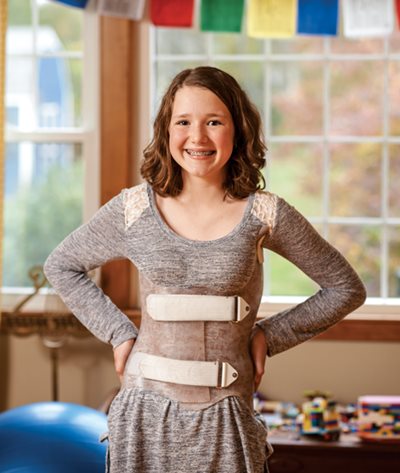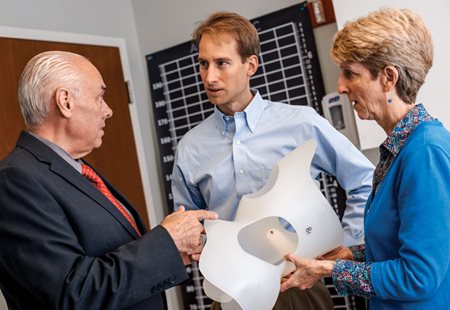 A combination of coincidence and luck brought Tamsin Clark (pictured at right) to Emerson to have a cast removed from her wrist. When pediatric orthopedic surgeon John Cahoy, MD, PhD, realized that the Maynard student has scoliosis, he asked about it. That was when Tamsin and her mother, Amy Rebecca Gay, learned that Emerson had established the first integrated scoliosis program in the region that provides the most advanced conservative treatment.
A combination of coincidence and luck brought Tamsin Clark (pictured at right) to Emerson to have a cast removed from her wrist. When pediatric orthopedic surgeon John Cahoy, MD, PhD, realized that the Maynard student has scoliosis, he asked about it. That was when Tamsin and her mother, Amy Rebecca Gay, learned that Emerson had established the first integrated scoliosis program in the region that provides the most advanced conservative treatment.
Tamsin was busy with school and playing goalie for her soccer team when her pediatrician suspected there might be something wrong with her spine. Nana McMahon, MD, conducted the standard screening for scoliosis, which indicated that Tamsin’s ribs were rotated. An x-ray revealed she had scoliosis; her spine had a 20-degree curve. The sideways curvature of the spine can be stable or increase over time, so she was monitored with regular checkups.
Tamsin was 10 when her scoliosis began to appear. Although there is a juvenile form of the condition, it most commonly is diagnosed in children age 10 to 12 and in the early teens. Scoliosis is found in approximately 3 percent of the population, more often in girls.
“Things were stable for two years,” says Ms. Gay. But by the spring of 2017, the curve in Tamsin’s spine had increased to 25 degrees. It was time for treatment, and her mother began doing research.
“I took Tamsin’s scoliosis diagnosis pretty seriously,” says Ms. Gay. “My mother-in-law, Tamsin’s grandmother, has scoliosis, and it was found too late for her to have treatment. From the beginning, I knew the goal was to avoid progression of Tamsin’s scoliosis and, specifically, to avoid surgery.” There is a genetic predisposition to scoliosis.
When they met Dr. Cahoy that day, Ms. Gay could appreciate that the Emerson Scoliosis Program combines the essential elements: oversight by a pediatric orthopedic surgeon, physical therapy with someone who is certified in the Schroth Method for scoliosis, and access to an experienced orthotist who fits patients with the WCR (Wood Cheneau Rigo) brace, which has proven itself in two decades of use in Europe.
Dr. Cahoy didn’t sugar-coat the work that lay ahead if Tamsin was to benefit from treatment. “When we saw Dr. Cahoy at the scoliosis clinic, he told Tamsin ‘I can’t wear your brace for you, and I can’t do the physical therapy for you,’” Ms. Gay recalls.
“I knew it was going to be difficult, but I’ll do anything for my back to be as straight as we can get it,” says Tamsin.
“I could see that Tamsin was motivated,” says Dr. Cahoy. “Those are the best kind of patients.”
An improvement — in just three months
 Tamsin began Schroth PT with Mary Evans, DPT, PT, (pictured on right) a pediatric and neurologic clinical specialist who is certified in the technique. “Schroth physical therapy includes exercises that strengthen the muscles around the spine, which are less developed in those with scoliosis,” she explains. “It also provides the patients with education about their specific curve and how to hold their body correctly to counteract the curve.”
Tamsin began Schroth PT with Mary Evans, DPT, PT, (pictured on right) a pediatric and neurologic clinical specialist who is certified in the technique. “Schroth physical therapy includes exercises that strengthen the muscles around the spine, which are less developed in those with scoliosis,” she explains. “It also provides the patients with education about their specific curve and how to hold their body correctly to counteract the curve.”
Patients are taught to breathe more fully. “The curvature of the spine pulls the ribs into an abnormal position,” says Ms. Evans. “We teach patients breathing exercises that engage the muscles around the ribcage. The goal is to change the shape of the ribs, which are curved backwards.” Untreated scoliosis can result in respiratory problems.
Glenn Paul, (pictured at left in above photo) the program’s orthotist, fitted Tamsin for her WCR brace. “Schroth PT and the WCR brace work together,” Mr. Paul explains. “This brace addresses more severe curves, including over 50 degrees, and reduces the need for surgery when compared with the standard braces. With other braces, the goal is to stop progression of the curves; with the WCR brace, in combination with Schroth PT, the goal is to reduce the curve.”
Dr. Cahoy (pictured at center in above photo) agrees that this approach to scoliosis treatment can change the outcome. “The breakthrough idea is that the WCR brace can be set in a way that allows the patient to optimally benefit from their Schroth physical therapy, which they integrate into their everyday life so that it affects their posture and allows their spine to grow straighter.”
Patients who wear their brace as prescribed, complete their Schroth PT sessions and continue with their home exercise regimen see results. Within three months of coming to the Emerson Scoliosis Program, Tamsin’s scoliosis had improved by every measure.
“Just a few years ago, we didn’t see that kind of response,” says Dr. Cahoy. “Although we cannot know the true outcome of any patient until they are done growing and out of their brace, we are optimistic about the impact of this combination therapy.”
The Gay-Clark family is pleased. “We found the cutting-edge approach to treatment that Tamsin needed,” says Ms. Gay. “We appreciate the convenient location, but it’s the collaboration of experts — everyone under one roof — that makes the difference. The team caring for Tamsin talks to each other.”
Early on, Tamsin decided to wear her brace outside her clothing rather than hide it, as most people do. “I don’t want to be secretive about having scoliosis,” she explains. “A lot of people ignore it or look away, but I want the opportunity to tell them about scoliosis. Also, it’s actually more work to wear it under your clothes.”
Now 13, she seldom needs reminding to do her Schroth exercises at home, which will continue for another year or more, until she stops growing. Tamsin’s grandmother wishes there had been more effective treatment for scoliosis when she was young. “She sees how my treatment is going and says ‘I love that you’re doing this,’” says Tamsin.
The Emerson Scoliosis Program is a collaboration that benefits patients
Treatment for scoliosis has evolved to become a collaboration of experts: experienced professionals who understand the value of working together to benefit the patient. At the Emerson Scoliosis Program, located at Emerson’s Westford Health Center, the team shares the same goal as the patient and family: avoid surgery, if possible.
“Physicians think differently about scoliosis today,” says Dr. Cahoy. “I think like a spine surgeon who doesn’t want to operate. If we see kids early, we can usually provide successful treatment that combines Schroth physical therapy and the WCR brace. And our program makes treatment easy to navigate for patients and families.”
Ms. Evans sees the power of Schroth PT. “I treated many patients with scoliosis prior to being certified in the Schroth Method,” she notes. “This offers them so much more, because it targets and strengthens the muscles in their spine.”
The WCR brace that Tamsin wears builds on many decades of advances. Other braces currently in use provide just a few pressure points, while the WCR brace, which is customized to the patient, provides 20. “It’s nothing like other braces,” says Mr. Paul, whose sole focus is scoliosis. “The WCR brace and Schroth PT are designed to work together. The only time I have seen this treatment approach not work was when patients either did not comply in wearing their brace or doing their exercises.”
“Because we are all experienced in treating scoliosis, we know that working together is the best approach,” says Dr. Cahoy. “We are providing world-class care for scoliosis locally, in our community, and the result is better outcomes for our patients.”
To make an appointment at the Emerson Scoliosis Program, please call 978-589-6880. The scoliosis clinic is held on the first and third Wednesday of each month. The Westford Health Center is located at 133 Littleton Road (Route 110) in Westford.

